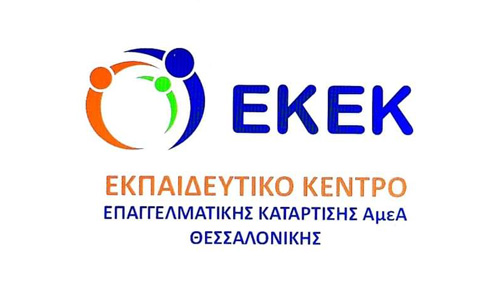ΕΚΕΚ ΑμεΑ Θεσσαλονίκης
Empowering students to mentor their peers to prepare them for work through simulated ‘real work’ environments within school
by Anastasia Anastasiadou and Zografia Xanthopoulou
Published 31/10/2022

by Anastasia Anastasiadou and Zografia Xanthopoulou
Published 31/10/2022
EKEK AMEA of THESSALONIKI is a vocational school for people with disabilities who have completed their compulsory education. The school is part of the Manpower Employment Organization, that recently changed its name into Public Employment Services. The main goal of the school is to prepare students for the world of work and also to help all students, so they will acquire knowledge and skills that will enhance their self-confidence and lead them to the conquest of autonomy. The school has modern laboratories equipped with all the necessary means so that students become familiar with the most propriate way in the specialties of Information Technology, agriculture, carpentry, weaving and cutting sewing. Their preparation is followed by their participation in the work centres so that students have the opportunity to be prepared professionally and to be connected with the labour market. Students are preparing for the most contemporary professions with the greatest demand.
In IT department students learn both the use of software programs and the use of machines such as printers. The principle of the department is the gradual autonomy in the work for all students.
In this example of good practice the beneficiaries are the students of the IT Department Work Centre. These students are people with a mental disability, aged between 18 and 30. All students have received their four-year basic education and they are now able to undertake tasks with little or no support at all. The principle applied by the teachers of the IT centre is that support and assistance is gradually reduced to the point where student can perform the work on his own. Once the student reaches this level, he assists a classmate in the same way. The ultimate goal is to create independence in daily work within IT and administration tasks. In this way they will increase their self-confidence and they will gain professional independence.
All students of the IT Department Work Centre, together with their teachers, participate in this case study. The aim of this practice is for students, within the school, to gain the confidence they need in order to secure a job. This self-confidence is gradually reinforced by the increasing autonomy enjoyed by students in carrying out certain tasks. Teachers gradually reduce the assistance they give to students up to the stage of absolute autonomy. Mentoring continues among students. In this way when a student has acquired the skills of a task, they can pass their knowledge on to a student who is not yet proficient.
What took place
The teachers within the IT Department Work Centre identify and record school work that can be performed by students of the department. They select students for specific tasks and start their guided instruction. Guidance is reduced as the students’ skills and knowledge increases with the ultimate goal of completing the work independently. The student then transmits the skills and knowledge they acquire to a classmate. They become their mentor and for a long time they work together in order to develop knowledge. This ensures that all the work of the school is carried out even when a student is absent. The tasks that students of the IT Department Work Centre are responsible for carrying out every day are:
Outcomes
Applying this practice has multiple benefits for students, who get the satisfaction of carrying out a project from beginning to end on their own. In addition to the knowledge and skills they acquire, boosting their self-confidence is the greatest advantage. By gradually withdrawing the assistance provided by the teacher, the student feels secure and acquires confidence in himself in a protected environment. When the student now conquers the skills required and completes the job on his own, he trusts himself and thus acquires a valuable asset for the job market. With the second stage, in which the student himself becomes a mentor for another classmate, the student has the opportunity to consolidate the acquired knowledge and assess the appropriateness of the skills he has acquired.
The autonomy that students acquire in the IT Department Work Centre is an asset that leads them to better and easier adaptation to working environments.
As an educational method it is easy to apply in different fields and to students of different age groups and levels of disability. It requires the teacher to be able to gradually withdraw their help and becomes an observer of the results of his work. It is a practice that gives students confidence and leads them to achieve their autonomy.
Student quotes
“It’s time to do distance learning, for whatever you need, I can help you.” (from a student who is in charge of installing the distance learning equipment, to a teacher.)
“We want to tour the guests in our school.” (from a participant in our school’s tour guide team.)